
The Kulturpalast Dresden (lit. 'Palace of Culture') is a modernist building built by Wolfgang Hänsch during the era of the German Democratic Republic. It was the largest multi-purpose hall in Dresden when it opened in 1969, and was used for concerts, dances, conferences and other events. The building underwent several years of reconstruction beginning in 2012 and opened with a new concert hall in April 2017.[1]
Unlike the other buildings in the Altmarkt square, the Kulturpalast is designed in the unadorned International Style. It is a stand-alone building with a floorspace of around 600 square metres (6,500 sq ft). It faces Wilsdruffer Straße and forms the second part of the Altmarkt square. Located east of Schloßstraße and southwest of nearby Neumarkt, which has been undergoing a reconstruction project since 2005, it lies in the center of the historic old town, which was largely destroyed during the firebombing of Dresden on 13 February 1945.
History
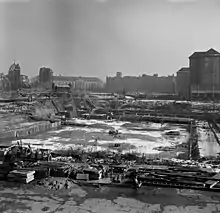
Planning and construction

The Kulturpalast was planned as a Socialist Classicist ensemble building. The intention was to erect a high-rise building in the style of the Seven Sisters in Moscow. In 1950, the GDR published The Sixteen Principles of Urban Design, whose important principles included a central square, cityscape-forming high-rise buildings, and wide main roads; the Kulturpalast was intended to fulfill the "dominant high ground" function.[2] This version of the project was never built.
The Kulturpalast was re-designed in the 1960s as the cultural center of the city and district of Dresden. The new design was a two-story cubic building based on plans by Leopold Wiel.[2] There were plans to build a third floor and a grandstand for parades on Ernst-Thälmann-Straße, but this was never done.
Refurbishment and renovation
Due to improper reconstruction work in the 1990s, it became necessary to renovate the Kulturpalast's fire protection equipment, leading to a five-month closure in the summer of 2007. In the weeks before the renovation fire engines were stationed next to the building during events.
The building closed for extensive renovations in July 2012.[3] Exterior construction work began in October 2013.[4] The new concert hall, designed by Gerkan, Marg and Partners, reopened in April 2017.[5]
Building
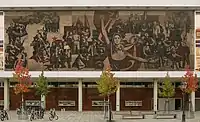

Top: mural; bottom: mural with inscriptions highlighted
Due to a special "tilting parquet", the Kulturpalast's original multi-functional ballroom could be used as either a 2435-seat auditorium with rising rows of seats or as a level banquet area. The building also contained a 192-seat studio theatre, classrooms, rehearsal and performance rooms, offices, and a restaurant.
The new concert hall, installed in the 2012–2017 reconstruction, has fewer seats but is designed to better suit its main tenant, the Dresden Philharmonic. As well as the main hall, the building now houses the main branch of the Dresden City Libraries and a performance space used by the cabaret group Die Herkuleskeule.
Artwork
_-_Bild_004.jpg.webp)
There is a 30-by-10.5-metre (98 ft × 34 ft) mural on the west side of the building, designed by Gerhard Bondzin and created in 1969 by a working group from the Dresden Academy of Fine Arts. The mural, titled Der Weg der roten Fahne (The Way of the Red Flag), is made of concrete slabs electrostatically coated with colored glass.[6][7] On the first floor is a 45-by-1.9-metre (148 ft × 6 ft) frieze by Heinz Drache and Walter Rehn titled Unser sozialistisches Leben (Our Socialist Life).[8]
The five main entrance doors were designed by Gerd Jaeger in 1969 and represent Dresden's development from a fishing village to a large city. The doors were cast in bronze by Pirner & Franz in Dresden.
When the building first opened it had three water features on the Wilsdruffer Straße side, consisting of terrazzo pools with large fountains in each basin and smaller fountains around the edges.[9] The fountains were removed in the course of construction work for an underground car park at Altmarkt.
Organ
The inclusion of an organ in state concert hall was not a certainty in the 1960s, as organ music was associated with churches. However, one was installed in 1970 shortly after the building opened. The original organ, built by Jehmlich Orgelbau Dresden, was based on a mobile frame so it could be moved on and off the stage. This mobility limited its size; the organ measured 7.4 by 7.4 by 1.5 metres (24 ft × 24 ft × 5 ft) and had 24 stops over two manuals and pedals.[10] When the Kulturpalast was renovated in 2012, the organ was dismantled and re-installed in St. Mary, Queen of Peace, Church in Cottbus.[10]
A new organ was installed in September 2017.[11] Built by Hermann Eule Orgelbau Bautzen, the new organ is larger than the original: it has 67 stops over four manuals and pedal, and measures 14.7 by 3.3 by 8.5 metres (48 ft × 11 ft × 28 ft).
Gallery
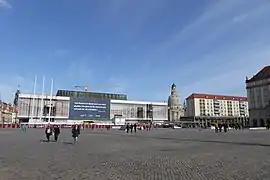 View over the Altmarkt to the Kulturpalast
View over the Altmarkt to the Kulturpalast2009_06.jpg.webp) Close-up with Dresden Frauenkirche and row building at Wilsdruffer Straße, 2009
Close-up with Dresden Frauenkirche and row building at Wilsdruffer Straße, 2009 View from the Frauenkirche over the reborn Neumarkt, Kulturpalast and Altmarkt, 2012
View from the Frauenkirche over the reborn Neumarkt, Kulturpalast and Altmarkt, 2012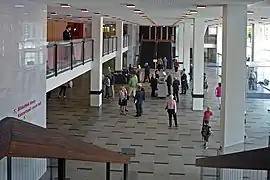 Foyer
Foyer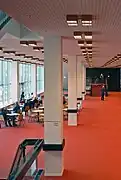 First floor with the wall frieze Unser sozialistisches Leben
First floor with the wall frieze Unser sozialistisches Leben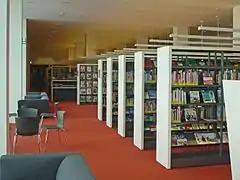 Central Library of the Municipal Libraries
Central Library of the Municipal Libraries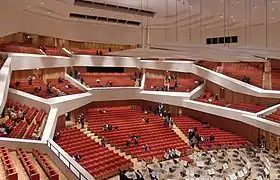 The new concert hall
The new concert hall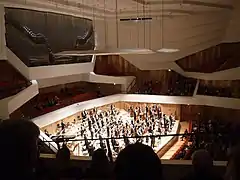 The Dresden Philharmonic with the new organ
The Dresden Philharmonic with the new organ
References
- ↑ Tietz, Jürgen (2017-05-03). "Späte Harmonien" [Late Harmonies]. Neue Zürcher Zeitung (in German). Retrieved 2020-05-09.
- 1 2 "Chronik des Bauwerks" [Construction Timeline]. Kulterpalast Dresden Erhalten (in German). Retrieved 2020-05-09.
- ↑ "Letzte Vorstellung im Dresdner Kulturpalast – Proteste gegen Umbau halten an" [Last performance in the Dresden Kulturpalast - protests against remodeling continue]. Dresdner Neueste Nachrichten (in German). 2012-07-23. Retrieved 2020-05-09.
- ↑ "Baustart im Dresdner Kulturpalast" [Start of construction in the Dresden Kulturpalast] (Press release) (in German). Landeshauptstadt Dresden. 2013-10-11. Retrieved 2020-05-09.
- ↑ Brachmann, Jan (2017-05-03). "Kulturpalast in Dresden: Romantik für das einundzwanzigste Jahrhundert" [Dresden Kulturpalast: Romanticism in the twenty-first century]. Frankfurter Allgemeine Zeitung (in German): 12.
- ↑ Klemm, Bettina (2013-09-09). ""Der Weg der roten Fahne" hält für die Ewigkeit" ["The Way of the Red Flag" lasts forever]. Sächsische.de (in German). DDV Mediengruppe. Retrieved 2020-05-09.
- ↑ Kober, Rudolf (1987). Wandbilder in der Deutschen Demokratischen Republik [Murals in the German Democratic Republic] (in German). Vol. 5. Berlin, Germany: Volk und Wissen. pp. 24–33, 39.
- ↑ "Foyers". Kulturpalast Dresden. Landeshauptstadt Dresden. Retrieved 2020-05-09.
- ↑ Kunst im öffentlichen Raum. Dresden, Germany: Kulturamt Dresden. 1996.
- 1 2 Jehmlich, Evelyn. "Cottbus, Kath. Propsteikirche St. Marien, 2 Manuale 24 Register, Gebr. Jehmlich 1970, Restaurierung 2015". Jehmlich Orgelbau Dresden (in German). Retrieved 2020-05-09.
- ↑ "Einweihung der Konzertorgel" [Inauguration of the Concert Organ] (PDF). Dresdner Philharmonie (in German). 2017-09-08. Archived from the original (PDF) on 2021-07-21. Retrieved 2020-05-09.
Literature
- Birk Engmann: Bauen für die Ewigkeit: Monumentalarchitektur des zwanzigsten Jahrhunderts und Städtebau in Leipzig in den fünfziger Jahren. Sax-Verlag, Beucha, Germany, 2006, ISBN 3-934544-81-9, German
- Wolfgang Hänsch: Haus der sozialistischen Kultur. In: Deutsche Architektur. Issue 4, 1968, P. 212–671, German
- Meinhard von Gerkan, Stephan Schütz (Ed.): Kulturpalast Dresden. Publisher Jovis Verlag, Berlin 2017, ISBN 978-3-86859-484-3, German
External links
- Website Kulturpalast Dresden, German
- Kulturpalast – Geistig- kulturelles Zentrum der Stadt und des Bezirkes Dresden. Palace of Culture - spiritual and cultural centre of the city and district of Dresden., German
- Historical facts about the Dresden Palace of Culture at the website of the Society Historischer Neumarkt Dresden, German
- Initiative to preserve the Dresden Palace of Culture (As of 2006), German
- Chronology of the reconstruction at the website of the city of Dresden, German
- Historical pictures from the construction period, German
- Sächsische Bibliographie, German
